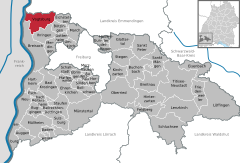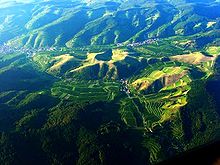Vogtsburg | |
|---|---|
Location of Vogtsburg within Breisgau-Hochschwarzwald district  | |
| Coordinates: 48°05′21″N07°37′54″E / 48.08917°N 7.63167°E | |
| Country | Germany |
| State | Baden-Württemberg |
| Admin. region | Freiburg |
| District | Breisgau-Hochschwarzwald |
| Government | |
| • Mayor (2023–31) | Benjamin Bohn [1] |
| Area | |
• Total | 37.40 km2 (14.44 sq mi) |
| Highest elevation | 557 m (1,827 ft) |
| Lowest elevation | 190 m (620 ft) |
| Population (2022-12-31) [2] | |
• Total | 6,242 |
| • Density | 170/km2 (430/sq mi) |
| Time zone | UTC+01:00 (CET) |
| • Summer (DST) | UTC+02:00 (CEST) |
| Postal codes | 79235 |
| Dialling codes | 07662 |
| Vehicle registration | FR |
| Website | www.vogtsburg.de |
Vogtsburg im Kaiserstuhl (Low Alemannic: Vogtsburg im Kaiserstuehl), often referred to as simply Vogtsburg (German pronunciation: [ˈfoːkt͡sˌbʊʁk] ⓘ ), is a town in the Kaiserstuhl, a volcanic region in the district Breisgau-Hochschwarzwald, Baden-Württemberg. It has a population of about 5,700 and was created on January 1, 1975 through the unification of six former municipalities, initially under the name Oberrotweil, [3] and was renamed to Vogtsburg im Kaiserstuhl in April 1977. [4] With its 5.4 square miles (14 km2) of vineyards, Vogtsburg is the biggest wine producing town in Germany.
Contents
- Geography
- Geographic position
- Climate
- Geology
- Neighboring towns
- Divisions
- History
- Gallery
- Policy
- Municipal Council
- Economy and infrastructure
- Court
- Education
- Streets
- Public transport
- Shipping
- Culture and objects of interest
- Museums
- Buildings
- Natural monuments
- Sport
- Sons and daughters of the town
- References
- External links



















